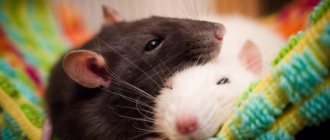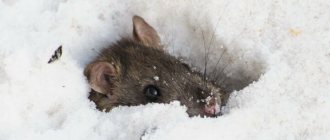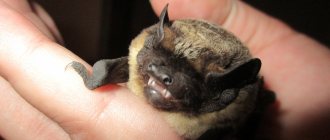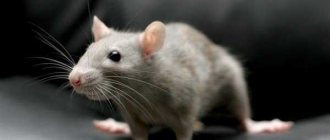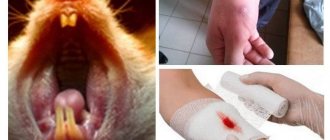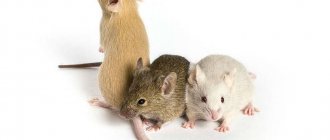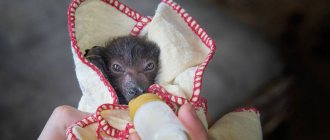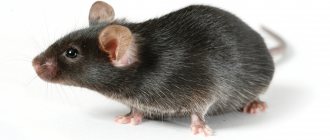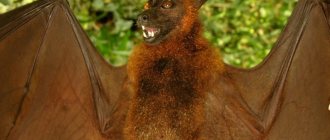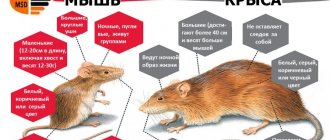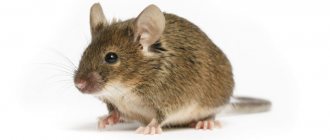Not only to eat! She's not alone yet! It turns out that sea mice are the names of fish (from two families - Antennariidae and Ogcocephalidae), as well as a species of polychaete worms (polychaetes). The latter will be discussed in our article.
Why could a worm be called a mouse? Of course, for the appearance. Although this animal lives under water, however, looking at it, you might think that this is really an ordinary mouse that decided to “wander” along the bottom of the sea.
Sea mouse (Aphrodita aculeata).
According to the scientific classification, the sea mouse (lat. Aphrodita aculeata) belongs to the family Aphroditidae, order Phyllodocida of the class Polychaete worms. The Latin name of the animal has a very unusual origin.
The body of the mouse is covered with numerous bristles.
Note the first word in the scientific name "Aphrodita". This is not a coincidence: the sea mouse is named Aphrodite in honor of the ancient Greek goddess of love (Aphrodite).
And all because the discoverers of this creature thought that the shape of the animal’s body was very reminiscent of female genitals... a little strange logic... however, the name ended up being beautiful.
What does a sea mouse look like?
The iridescent iridescence of the bristles is a unique feature of sea mice.
The entire body of the animal is covered with numerous bristles, similar in appearance to the fur of a small rodent. The length of the sea worm can be from 10 to 20 centimeters, the width is about 5 centimeters. The entire body of a sea mouse is divided into numerous segments, the number of which can range from 35 to 40.
Each such segment has some kind of process, scientifically called parapodia. These processes are necessary for the animal to move along the seabed.
Depending on how and from which side the light falls on this animal, it can change its color. Sometimes it seems that the sea mouse has a grayish-olive tint, and sometimes the tips of the bristles even shimmer in different colors.
This phenomenon could not but interest scientists, but we will talk about this further. In the meantime, about where you can find sea mice in natural conditions.
Where do representatives of this species live?
The sea mouse is found in the Atlantic Ocean and Mediterranean Sea.
The animal is widespread only in the northeast of the Atlantic Ocean; in other parts it is much less common.
As a rule, the mouse fish (a photo of the worm can be seen on the page) prefers muddy water and chooses a muddy bottom for its settlement. The mouse goes to a depth of up to 2 kilometers only if there is enough sand at the bottom, in which it spends most of its life. Individuals of this species are often washed ashore during a storm.
The unique structure of the bristles on the back of the sea creature has greatly intrigued scientists. Scientists from the Norwegian University of Science and Technology were the first to undertake research. They decided to find out whether the channels located inside the bristles could be used as a template for making nanowires. Research confirmed the scientists' assumptions, which made it possible to increase the length of the nanowire from 0.2 mm to 2 cm. The new method of making wires has become more economical and easier. Thus, the sea animal helped make a whole breakthrough in the field of technology.
Lifestyle and basis of the diet of sea mice
Sea mice can be found in the North Sea, Baltic Sea and Mediterranean Sea.
Despite its completely harmless appearance, the sea mouse is a predatory animal. However, among the representatives of sea mice there are also those who feed on plants. Predators consume small crustaceans, gastropods, and small worms.
This type of polychaete worm has been little studied by researchers, so information about its reproduction and any details of its lifestyle is currently limited.
Japanese dwarf mouse as a pet
These cute animals are native to Southeast Asia and Japan.
In the wild, their size will be slightly smaller than at home. In their homeland, representatives of this species were used in the laboratory in the same way as specially bred laboratory mice are now used. These rodents are also known around the world as “dancing mice.” This is due to the fact that animals quite often suffer from diseases of the middle ear, and almost completely lose the ability to navigate in space. Due to this, the rodent makes strange movements in one place, which touches the hearts of many people.
It is important to remember that this is a sign of a disease and the animal suffers greatly.
If you decide to purchase such an animal, it is worth learning about the main options that you have. You can start:
- one female;
- one male;
- a couple of females;
- male and female;
- a male and several females.
You should not buy a couple of males and put them in the same cage. They quite aggressively defend the right to territory and can even bite their competitor to death.
Females are friendlier than males, so this type of keeping is acceptable. However, females can also argue with each other, starting fights. As a rule, they do not end in anything serious.
A male and a female are practically a full-fledged mouse “family”, but it is worth spending time with your pets, since they will still experience some lack of communication. And finally, one male and several females is the most optimal keeping option, since such families are also found in the wild. But such a set is suitable only for experienced breeders who remember that constant reproduction exhausts the body of females and frequent pregnancy and childbirth cannot be allowed.
What is it about this unusual animal that has interested physicists?
As we have already said, the back of the sea mouse is covered with long bristles. The angle of incidence of the light beam can color the surface of the animal's body differently. For example, if the angle of incidence is straight, the bristles appear red. If a ray of light hits the surface of the bristles at an angle, they turn yellow, blue or green. What's the secret?
The abdomen of a sea mouse.
The mystery lies in the special structure of the bristles, which resembles a honeycomb. All these “honeycombs” are strictly ordered. It is thanks to the light beam hitting these structural elements that the unique refraction of the stream of light occurs and turns it into multi-colored “lights”.
Scientists from one of the universities in Norway engaged in developments in the field of nanotechnology have already become interested in this phenomenon of the sea mouse. They soon plan to borrow this design to improve the process of creating nanowires.
If you find an error, please select a piece of text and press Ctrl+Enter.
Description of the field mouse, belonging to the animal world
The field mouse looks almost like a house mouse, but, according to many, it is much cuter. She has a more miniature muzzle, a short tail, and neat compact ears. The common field mouse is included in the hamster subfamily, which explains its external similarity to these domesticated rodents.
This small animal has a discreet coloration, which allows it to remain inconspicuous to numerous predators. It is difficult for large birds to see a mouse from the air - it blends in with compacted grass, bushes, and soil. And terrestrial predators have difficulty distinguishing it in thickets of rye or wheat. A person rarely manages to detect the mouse itself or its offspring, but only traces of its invasion:
- spoiled grain;
- litter;
- gnawed root vegetables.
The search for the pest is hampered by its nocturnal lifestyle and incredibly sensitive hearing. During the day it is almost impossible to catch a vole destroying stocks. If she nevertheless decided to make a raid during the day, she would definitely pick up sound vibrations at a distance of several tens of meters. And she only needs a few seconds to retreat from the “crime scene.”
This mouse with a wide black stripe on its back is larger than the rodent that lives in houses and outbuildings. With large food supplies and the absence of predators from which one has to constantly run away, the animal can reach 12 cm in length. This is approximately 30–75% of the total size. The mouse has a flexible, mobile body, so it can easily:
- climbs trees;
- penetrates narrow winding passages.
The tail of voles is long, for example, in adults it reaches 8–10 cm. From a distance it may seem that it is completely naked, but this is not so. The mouse's tail is covered with:
- durable protective leather scales;
- tiny coarse hairs.
The fact that it is cold in rodents is not true. Its temperature is the same as that of the entire vole body. The tail can be cold, but only if the animal is frozen.
This part of the vole is a kind of thermostat. In hot conditions, its blood vessels constrict, slowing down blood circulation and helping to cool the body. In winter, on the contrary, they expand. The temperature of the blood passing through them rises. Entering the body, it quickly warms it.
The tail also serves as a balancer for the vole, allowing it to maintain balance when crawling along thin tree branches. And in a fight, a rodent can use it to fight off small predators - rats and birds.
Coat and color
According to the zoological description, the vole differs from other species of mice by a wide stripe on its back. It starts between the ears, runs throughout the body and ends in the tail area. The area of the brown stripe has the longest, thickest hairs. They are quite rigid, unlike the voles located on the stomach. There are hairs:
- greyish;
- softer;
- short.
Even a small vole has a mobile, muscular body. The mouse easily climbs the stems of cereals, flexible branches of bushes and trees, maintaining excellent balance. The mouse begins to store fat closer to autumn in order to wait out the harsh winter without any problems. The rodent's limbs are short - the length of the largest specimen does not exceed 3 cm.
Each paw is equipped with claws dulled from regular digging of the ground in search of food. They are powerful enough to resist a predator attack. With the help of its claws, the vole easily climbs not only trees, but also the brickwork of houses and barns. In newborn mice they are thin and sharp, but as they grow older they become flat and wide.
Head
The field mouse's ears are round and small, and its black eyes are set close to each other. The muzzle is pointed, but not as pointed as that of rodents living in houses, barns, and courtyard buildings. The hair on the vole's head is shorter and resembles bristles when touched. In some species, the hairs on this part of the body are somewhat lighter and thinner.
Description of the field mouse:
- Body length no more than 12 cm, excluding tail. The thin tail makes up 70% of the body length.
- The body is oblong. The hind feet are elongated and protrude forward when running.
- Long muzzle, small round ears, oblong nose.
The fur is hard, rough, short. The colors can be different - gray, brown, ocher or beige. A straight line of black or brown shade runs along the spine. The color of the abdomen is snow-white. At the base the hairline has a dark tint. Small spots may be present on the chest.
Housing of individuals
The Japanese dancing mouse must live in a cage specially equipped for this purpose. As a rule, owners choose cages with bars no more than half a centimeter apart, which prevents the animal from escaping while simultaneously providing high-quality ventilation. The housing should contain items for the animal's leisure time:
- Wheel.
- Sticks.
- Shelves.
- Stairs.
- Running surface.
It must be taken into account that all surfaces should not have protrusions or crevices where a pet’s paw could get stuck. It is also necessary to take into account the size of the animal and select a running wheel that will not be too heavy and uncomfortable.
The Japanese mouse emits a pungent odor characteristic of all its relatives. In this regard, cleaning the cage should be carried out at least once every three days, otherwise both your home and the level of hygiene in your pet’s cage will suffer from the constant smell. As a filler, you can use ordinary medium-sized sawdust. It is not recommended to use sawdust with flavoring; they often provoke allergic reactions.
In housing, the animal must equip its own house. You can purchase a ready-made one at a pet store - they offer various wooden, ceramic or plastic options. For a nest, you can provide the animal with pieces of napkins, which he will independently use in the house.
Conditions of detention
A bat will cause trouble, because in nature it constantly flies, so you will need a large enclosure for free living. Defecation occurs during flight, which means the cleanliness of the floor is at risk.
For the digestive system to function properly, the air must be heated to +30 degrees, otherwise the animal will die. His body temperature is not constant and depends on movement activity.
In the habitat, temperature indicators must change more than once a day. This problem is solved by dividing the enclosure into compartments, partitioned with a metal mesh, leaving holes in it.
The device will allow the resident to choose a comfortable mode himself.
Hierarchy
The hierarchy of the house mouse established in the process of evolution is as follows: one colony or family group of mice is under the strict leadership of a dominant male. Under his patronage there are several females who continuously produce offspring. The offspring are raised in the family “collective” until they reach sexual maturity (up to 2 months), after which all the “new ones” are expelled from the colony, since during this time the females manage to bear another brood. Thus, there are never representatives of several generations in a family at once. Just a couple of the most recent ones. The rest, expelled from their native home, are forced to create their own families.
Many families, for whom there was no room in the residential building (barn, shed) divided between the “clans,” remain on the street when winter comes and die.
Decorative rodents
Selection has provided hundreds of different subspecies of mammals that sing and “waltz,” differing in their specific coat tone.
There are albino animals, and there are black, ash, and cream colored animals.
When choosing an animal, give preference to the following breeds of domestic mice:
- A miniature Japanese mouse, no more than 5 cm long, whose white skin is decorated with black and brown spots. Friendly and clean, she is a supporter of the nocturnal lifestyle and gives birth to up to 7 cubs.
- Spiny mice with needles on their back. It is reddish-brown or blackish-red in color. There is a hump of fat on the neck. It has an elongated nose, bulging eyes, and oval ears. The active animal loves people and becomes attached to them.
- A striped African specimen with an interesting coloration of light and dark stripes. It does not emit a smell and likes to climb on vertical surfaces. The mouse is extremely cowardly. Sensing trouble, she pretends to be lifeless or jumps up to two meters high. Does not grow longer than 10 cm.
Features, lifestyle, habits, sense organs, life expectancy
The mammal house mouse is a very mobile, fast and nimble creature. In open areas, such an animal can reach speeds of up to 13 km/h, and their agility makes these creatures capable of shortening and eluding a predator, even if it catches up with it.
Such mice lead a predominantly twilight or nocturnal lifestyle. They are very shy and have hyperdeveloped sensory organs. Sensitive paws detect any vibration of the earth's surface, and a heightened sense of smell and hearing are able to distinguish the slightest vibrations of odors and sound waves.
They do not need lighting at all for normal orientation. They are well oriented using their sense of smell and sensitive whiskers. Their only flaw is their eyesight. It perceives relatively well what is happening at a great distance from them, while close up the object in front of their eyes is blurred and does not have a clear shape.
During the warm season, mice can move from human homes to the street. They feel great in nature. They build small burrows with several exits. The main abode is covered with bird feathers and dry leaves. Animals that exist in virgin nature, isolated from humans, are forced to create a storage facility in their burrows, in which the animals store food for the winter. But rodents living within a residential area invariably return for the winter to warm human homes or agricultural buildings, where they spend the winter very well, causing a lot of inconvenience to people.
Mice of this species do not live long in the wild - from a year to a year and a half. But in captivity (if you can call the cozy walls of a residential building with garbage cans filled with food) they can live twice as long.
Dream Interpretation - Fish
See the interpretation: by the names of the fish, as well as the net, the trap. Fish in a dream symbolize coldness, illness, and indifference. Seeing a gnawed fish skeleton in a dream is a harbinger of misfortune, collapse of plans and disappointments. Fishing in a dream is a sign of ingratitude, useless work, a waste of time and effort. Seeing a fish caught by others in a dream foreshadows illness, and for women, pregnancy. If in a dream you watch the float of your fishing rod, which is calmly swaying on the water, then the fulfillment of your desire is postponed. If in a dream the float twitches and you catch a fish, then you can count on your plans being fulfilled. Catching a big fish in a dream means that a profitable marriage awaits you. Sometimes such a dream predicts a big and profitable business. Watching the fish you catch means that you will soon have serious plans for the future. Catching a lot of fish in a dream is a sign of big profits. The larger the fish, the more money you will receive. Catching a lot of small fish in a dream is a sign of a lot of trouble, from which there will be little benefit or little money. But fishing with nets, drags or seines means that you should be wary of risky activities. However, such a dream portends success for those people who have lost something (or someone) and are trying to find it. Not catching anything in a dream means that your plans will not come true. Fishing hooks in a dream portend danger. Such a dream may mean that your enemies have prepared a cunning trap for you. A motley, brightly colored fish in a dream warns you of the danger of poisoning or deception. For patients, such a dream foreshadows death. Such a dream can also foreshadow insult or quarrels. A red fish in a dream predicts great experiences, inflammation, or the discovery of some secret. If you dream that you take a fish in your hands, and it slips out of your hands, then you will have to deal with such a cunning person whom you will never be able to catch or expose. It is also believed that lake fish seen in a dream portends happiness and prosperity. A dream in which you caught a bony fish predicts obstacles in business and failures in the implementation of plans. Eating fish in a dream is considered a good omen, as long as it is not raw. Eating raw fish in a dream means that losses, obstacles in business and disappointment await you. But if it is also full of bones, then disappointment or failure awaits you. A dead fish floating on the water predicts that your wishes will not come true. Watching a fish splashing in the water portends receiving a gift or very good news. Sometimes such a dream predicts anxiety and troubles associated with your work. Feeding fish in a dream is a sign of reconciliation with enemies whom you will charm with your charm. Seeing fish in your bed in a dream is a sign of illness. For those who go on a journey by water, the dream foretells the danger of a shipwreck or other misfortune. For pregnant women to dream that they gave birth to a fish, the dream predicts that their unborn child will be in poor health and will not live long. Sometimes such a dream foretells them a miscarriage. It is believed that rotten fish in a dream foreshadows failures in business or in your personal life. If you saw fishing gear in a dream, then you should be wary of deception or some kind of cunning trap. Fatty fish in a dream is a sign of diseases associated with tumors or inflammation. Fishermen in a dream are a sign of unreliable friends who should not be relied on.
Rodent lifestyle: what does it eat, how does it reproduce, does it hibernate in winter?
The mouse consumes a minimum of 5 g of food and 20 ml of water per day. Without food or drink, it dies within a week. Life expectancy in nature is 1–1.5 years. In favorable conditions, the animal can live longer, up to 2–3 years. The longevity record was set by a laboratory mouse in 2005 - 1819 days (about 5 years).
Rodents are very prolific; the active breeding phase begins in the spring; with the onset of cold weather, the reproduction process slows down. At the same time, 5–8 bald, blind cubs are born. The weight of the mouse is only 1–2 g. The female eats the weak and non-viable ones. The same fate awaits pups born in times of famine, when there is no way to feed them.
Rodents live in colonies consisting of females and several generations of offspring. Males prefer to lead a solitary lifestyle. Field mice usually make burrows underground at a depth of about 10–20 cm (sometimes deeper - up to half a meter). They consist of branched passages leading to water, places for sleeping and storing supplies.
The peak activity of mice occurs at night. They require a lot of food to provide energy to their bodies as they are extremely active. Animals are constantly gnawing on something. In addition to regular food, various hard objects and materials are used - wood, brick, concrete, plastic, rubber. This helps voles wear down their teeth, which grow throughout their lives.
With the onset of winter, the animals' activity decreases, but they do not hibernate, setting up shelters in the snow or straw. To survive in winter, mice stock up on supplies from mid-summer. Mice living near humans do not store food, because they usually do not have problems with food.
The feeding behavior of the field mouse is the same as that of small rodents. Even when starving, she will not eat other animals or fish, but she will happily snack on insects. Living in the field, the mouse eats cereals - wheat, oats, corn, buckwheat. And not only the grains themselves, but also the following parts of plants:
- stems;
- spinous processes of spikelets;
- succulent leaves.
Voles living in meadows eat fruits and stems of plants, grains of milky ripeness. They dig up young roots, bulbs and rhizomes, and in the spring they gnaw buds from low bushes. Voles are also attracted to flowers with sweet nectar. In the forests they also do not go hungry. After all, they contain a lot of cones with nuts and young trees with delicate, thin bark.
Mice are the scourge of agriculture. Not only do they destroy crops, but often already harvested grain, stocks of potatoes, carrots, beets, and legumes are destroyed. Once a rodent enters a barn, it remains there forever. It is dry, warm, and has a lot of food. Considering the rate of reproduction of voles, reserves disappear quite quickly.
Biology
The biology of the small sea mouse has been little studied. It lives on sandy biocenoses to a depth of 20 m; in winter it moves to greater depths. Spawning in summer, in portions. In the Gulf of Odessa, spawning was observed from late May to mid-September. Off the coast of Bulgaria, eggs were found from mid-June to early September at a water temperature of 20-25°C in the coastal area, sporadically at a distance of 5-7 miles from the coast; larvae were also caught here.
Eggs and larvae are pelagic. The 4-7 mm long larvae are covered with a dense network of dark brown melanophores, which makes them look like floating fragments of the brown alga Cystoseira barbata, which is indifferent to predators.
A whitebait 5.5 mm long was caught on September 3 in the middle part of Novorossiysk Bay at a depth of 18 m. Fry of this species and larvae of the same or another species 3-4.7 mm long were caught at a depth of 15 m at a water temperature of 15-16°C before entering the Novorossiysk Bay at the end of June, in August and September, 1.7-5.2 mm long, were found in the middle part of the Novorossiysk Bay at a depth of 10-20 m: at a temperature of 23-24°C. Fry 27-33 mm long were caught in the bay on shell rock and silt, in August sometimes 5-6 mm long. The transition to a benthic lifestyle occurs at a length of 5-7 mm.
